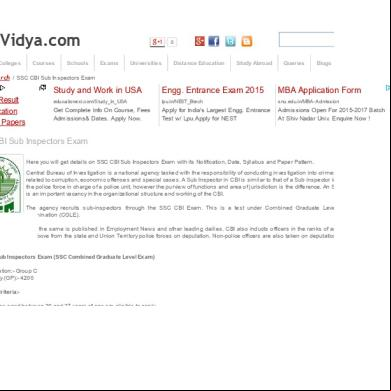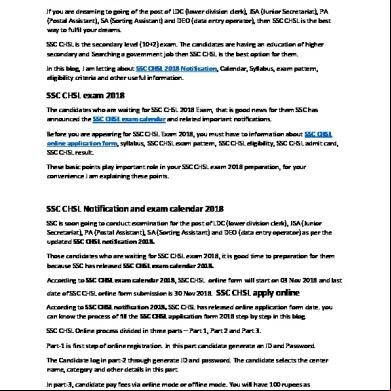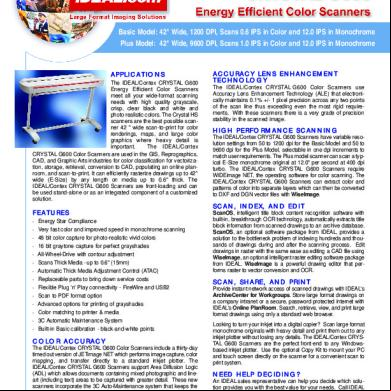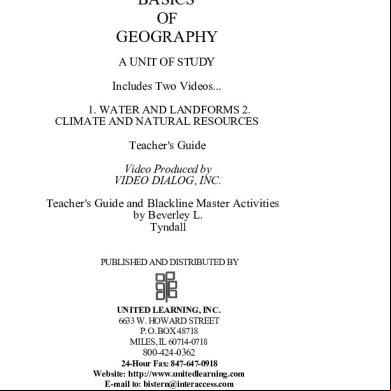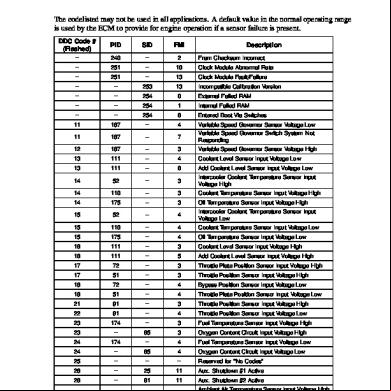Ssc Cbi Sub Inspectors Exam Date, Notification, Syllabus, Pattern q3653
This document was ed by and they confirmed that they have the permission to share it. If you are author or own the copyright of this book, please report to us by using this report form. Report 3b7i
Overview 3e4r5l
& View Ssc Cbi Sub Inspectors Exam Date, Notification, Syllabus, Pattern as PDF for free.
More details w3441
- Words: 1,738
- Pages: 6
EduVidya.com Home
Colleges
Courses
Schools
Search
0
Exams
Universities
Distance Education
Study Abroad
Queries
Blogs
Search
Home / Search / SSC CBI Sub Inspectors Exam
► SSC Result ► Notification ► Exam Papers
Study and Work in USA
Engg. Entrance Exam 2015
MBA Application Form
educationext.com/Study_In_USA
lpu.in/NEST_Btech
snu.edu.in/MBA-ission
Get Complete Info On Course, Fees issions& Dates. Apply Now.
Apply for India's Largest Engg. Entrance Test w/ Lpu.Apply for NEST
issions Open For 2015-2017 Batch At Shiv Nadar Univ. Enquire Now !
SSC CBI Sub Inspectors Exam
Find us on Facebook
Eduvidya.com Here you will get details on SSC CBI Sub Inspectors Exam with its Notification, Date, Syllabus and Paper Pattern. Central Bureau of Investigation is a national agency tasked with the responsibility of conducting investigation into crimes related to corruption, economic offenses and special cases. A Sub Inspector in CBI is similar to that of a Sub inspector in the police force in charge of a police unit, however the purview of functions and area of jurisdiction is the difference. An SI is an important vacancy in the organizational structure and working of the CBI. The agency recruits sub-inspectors through the SSC CBI Exam. This is a test under Combined Graduate Level examination (CGLE). The recruitment notice of the same is published in Employment News and other leading dailies. CBI also inducts officers in the ranks of an Inspector of Police and above from the state and Union Territory police forces on deputation. Non-police officers are also taken on deputation in CBI. SSC CBI Sub Inspectors Exam (SSC Combined Graduate Level Exam) • Classification:- Group C • Grade Pay (GP):- 4200 Eligibility Criteria:• Candidates aged between 20 and 27 years of age are eligible to apply. • Bachelors degree from a recognized university or an equivalent qualification Age Relaxation:SC/ST - 5 years OBC - 3 years SSC CBI Sub Inspectors Exam Paper Pattern:-
Like
4,140 people like Eduvidya.com.
The Examination is conducted in three stages (tiers) as indicated below: • Tier-I: Written Examination (Objective Multiple Choice Type) • Tier-II:Written Examination (Objective Multiple Choice Type) • Tier-III- Personality Test cum Interview/Computer Proficiency Test/ Skill Test (wherever applicable)/document verification. Tier I Exam:A. General Intelligence + Reasoning=50 marks B.Gen.Awareness = 50marks C. Quantitative Aptitude = 50 marks D. English Comprehension =50 marks Total Marks- 200 Duration: 02 hours Tier II Exam:• I.Quantitative Abilities : 200 marks (100 Questions) Duration: 2 hours • II.English Language & Comprehension: 200 marks. Duration : 2 hours Total Marks : 400 Total Duration: 4 hours. This will be followed by personality test and interview of 100 marks. Marking Scheme:• There is negative marking of 0.25 marks for every wrong answer in Tier-01. • There is negative marking of 0.50 marks for every wrong answer in paper I of Tier- 02. • There is negative marking of 0.25 marks for every wrong answer in paper II or Tier- 02. SSC CBI Sub Inspectors Exam Syllabus:TIER-I Exam A. General Intelligence & Reasoning: It would include questions of both verbal and non-verbal type. This component may include questions on analogies, similarities and differences, space visualization, spatial orientation, problem solving, analysis, judgement, decision making, visual memory, discrimination, observation, relationship concepts, arithmetical reasoning and figural classification, arithmetic number series, nonverbal series, coding and decoding, statement conclusion, syllogistic reasoning etc. The topics are, Semantic Analogy, Symbolic/Number Analogy, Figural Analogy, Semantic Classification, Symbolic/Number Classification, Figural Classification, Semantic Series, Number Series, Figural Series, Problem Solving, Word Building, Coding & de- coding, Numerical Operations, symbolic Operations, Trends, Space Orientation, Space Visualization, Venn Diagrams, Drawing inferences, Punched hole/pattern – folding & un- folding, Figural Pattern– folding and completion, Indexing, Address matching, Date & city atching, Classification of centre codes/roll numbers, Small & Capital letters/numbers coding, decoding and classification, Embedded Figures, Critical thinking, Emotional Intelligence, Social Intelligence, Other sub -topics, if any. B. General Awareness:-
Are you Interested in Getting Education Help like issions, Career etc.. Get Free Guidance on issions, Education
Questions in this component will be aimed at testing the candidates general awareness of the environment around him and its application to society. Questions will also be designed to test knowledge of current events and of such matters of every day observations and experience in their scientific aspect as may be expected of any educated person. The test will also include questions relating to India and its neighbouring countries especially pertaining History, Culture, Geography, Economic Scene, General Policy & Scientific Research. C. Quantitative Aptitude :The questions will be designed to test the ability of appropriate use of numbers and number sense of the candidate. The scope of the test will be computation of whole numbers, decimals ,fractions and relationships between numbers, Percentage. Ratio & Proportion,Square roots, Averages, Interest, Profit and Loss, Discount, Partnership Business, Mixture and Alligation, Time and distance, Time & Work, Basic algebraic identities of School Algebra & Elementary surds, Graphs of Linear Equations, Triangle and its various kinds of centres, Congruence and similarity of triangles, Circle and its chords, tangents, angles subtended by chords of a circle, common tangents to two or more circles, Triangle, Quadrilaterals, Regular Polygons , Circle, Right Prism, Right Circular Cone, Right Circular Cylinder, Sphere, Hemispheres, Rectangular Parallelepiped, Regular Right Pyramid with triangular or square base, Trigonometric ratio, Degree and Radian M easures, Standard Identities, Complementary angles, Heights and Distances, Histogram, Frequency polygon, Bar diagram & Pie chart D. English Comprehension: Candidates’ ability to understand correct English, basic comprehension and writing ability would be tested in this section.
Loan, Career, Entrance Exam, Studyabroad from EduVidya.com.
Click here
EduVidya.com HelpDesk!
Syllabus for TIER II Exam:Paper-I :
Earth Quiz
Do You Really Know Your Planet? Check your Knowledge Questions will be designed to test the ability of appropriate use of numbers and number sense of the candidate. The scope of the test will be here and Win Prizes the computation of whole numbers, decimals ,fractions and relationships between numbers, Percentage. Ratio & Proportion,Square roots, Averages, Interest, Profit and Loss, Discount, Partnership Business, Mixture and Alligation, Time and distance, Time & Work, Basic algebraic identities of School Algebra & Elementary surds, Graphs of Linear Equations, Triangle and its various kinds of centres, Congruence and similarity of triangles, Circle and its chords, tangents, angles subtended by chords of a circle, common tangents to two or more circles, Triangle, Quadrilaterals, Regular Polygons , Circle, Right Prism, Right Circular Cone, Right Circular Cylinder, Sphere, Hemispheres, Rectangular Parallelepiped, Regular Right Pyramid with triangular or square base, Trigonometric ratio, Degree and Radian Measures, Standard Identities, Complementary angles, Heights and Distances, Histogram, Frequency polygon, Bar diagram & Pie chart Quantitative Ability:-
Paper-II:English Language & Comprehsion: Questions in this components will be designed to test the candidate’sunderstanding and knowledge of English Language and will be based on spot the error, fill in the blanks,synonyms, antonyms, spelling/detecting mis- spelt words, idioms & phrases, one word substitution, improvement of sentences, active/ive voice of verbs, conversion into direct/indirect narration, shuffling of sentence parts, shuffling of sentences in a age, cloze age & comprehension age. Paper-III : Statistics for Investigator Grade-II, Ministry of Statistics & Programme Implementation & Compiler in RGI. Collection Classification and Presentation of Statistical Data– Primary and Secondary data, Methods of data collection; Tabulation of data; Graphs and charts; Frequency distributions; Diagrammatic presentation of frequency distributions. Measures of Central Tendency- Common measures of central tendency – mean median and mode; Partition values-quartiles, deciles, percentiles. Measures of Dispersion- Common measures dispersion– range, quartile deviations, mean deviation and standard deviation; Measures of relative dispersion.
Moments, Skewness and Kurtosis– Different types of moments and their relationship; meaning of skewness and kurtosis; different measures of skewness and kurtosis. Correlation and Regression– Scatter diagram; simple correlation coefficient; simple regression lines; Spearman’s rank correlation; Measures of association of attributes; Multiple regression; Multiple and partial correlation (For three variables only). Probability Theory– Meaning of probability; Different definitions of probability; Conditional probability; Compound probability; Independent events; Bayes’ theorem. Random Variable and Probability Distributions – Random variable; Probability functions; Expectation and Variance of a random variable; Higher moments of a random variable; Binomial , Poisson, Normal and Exponential distributions; t distribution of two random variable (discrete). Sampling Theory– Concept of population and sample; Parameter and statistic, Sampling and non-sampling errors; Probability and nonprobability sampling techniques(simple random sampling, stratified sampling, multistage sampling, multiphase sampling, cluster sampling, systematic sampling, purposive sampling, convenience sampling and quota sampling); Sampling distribution(statement only); Sample size decisions. Statistical Inference- Point estimation and interval estimation, Properties of a good estimator, Methods of estimation (Moments method, Maximum likelihood method, Least squares method), Testing of hypothesis, Basic concept of testing, Small sample and large sample tests, Tests based on Z, t, Chi -square and F statistic, Confidence intervals. Analysis of Variance- Analysis of one- way classified data and two - way classified data. Time Series Analysis- Components of time series, Determinations of trend component by different methods, Measurement of seasonal variation by different methods. Index Numbers- Meaning of IndexNumbers, Problems in the construction of index numbers, Types of index number, Different formulae, Base shifting and splicing of index numbers, Cost of living Index Numbers, Uses of Index Numbers. How to apply for SSC CBI Exam:•Prescribed application for this exam can be submitted either online or offline. •Click here for instructions for filling up the online application form. (http://ssc.nic.in/notice/examnotice/CGLE-2014%20Notice.pdf/) •Candidates submitting application form online are required to retain registration number for future correspondence with commission. •Online applicants need not submit printout of their application form. •Candidates applying through offline mode are required to submit their application before the last date for form submission. SSC CBI Sub Inspectors Exam (CGL) Dates:Date Of Notification:- 18-01-2014 Last Date Of Receiving Application:- 14-02-2014 Date Of Examination:- 27-04-2014,04-05-2014 For more details
Click Here
(5 out of 5 based on 1 Ratings)
Whom do you see as next Captain of Indian Cricket Team? Sachin Sehwag Virat Kohli Harbhajan Singh Suresh Raina
Submit Next Vote : What do you want to drive today?
► SSC Exam Question
Comments
Name
:
► Get Exam Syllabus
► Exam Practice
Reviews
Questions
Comments :
Vote Next
► Exam Time
Email
:
Mobile
:
Submit
Most Searched Queries Engineering ission in Assam CAT Quantitative Aptitude Syllabus Diploma Courses after 12th Science Courses after Graduation in Engineering Courses after BDS Top Medical Colleges in Rajasthan Top Dental Colleges in Gujarat Top Arts Colleges in MP IAS History Syllabus Top Dental Colleges in Pune more...
us With Us & Conditions Sitemap Copyright © 2014-15 www.eduvidya.com
Colleges
Courses
Schools
Search
0
Exams
Universities
Distance Education
Study Abroad
Queries
Blogs
Search
Home / Search / SSC CBI Sub Inspectors Exam
► SSC Result ► Notification ► Exam Papers
Study and Work in USA
Engg. Entrance Exam 2015
MBA Application Form
educationext.com/Study_In_USA
lpu.in/NEST_Btech
snu.edu.in/MBA-ission
Get Complete Info On Course, Fees issions& Dates. Apply Now.
Apply for India's Largest Engg. Entrance Test w/ Lpu.Apply for NEST
issions Open For 2015-2017 Batch At Shiv Nadar Univ. Enquire Now !
SSC CBI Sub Inspectors Exam
Find us on Facebook
Eduvidya.com Here you will get details on SSC CBI Sub Inspectors Exam with its Notification, Date, Syllabus and Paper Pattern. Central Bureau of Investigation is a national agency tasked with the responsibility of conducting investigation into crimes related to corruption, economic offenses and special cases. A Sub Inspector in CBI is similar to that of a Sub inspector in the police force in charge of a police unit, however the purview of functions and area of jurisdiction is the difference. An SI is an important vacancy in the organizational structure and working of the CBI. The agency recruits sub-inspectors through the SSC CBI Exam. This is a test under Combined Graduate Level examination (CGLE). The recruitment notice of the same is published in Employment News and other leading dailies. CBI also inducts officers in the ranks of an Inspector of Police and above from the state and Union Territory police forces on deputation. Non-police officers are also taken on deputation in CBI. SSC CBI Sub Inspectors Exam (SSC Combined Graduate Level Exam) • Classification:- Group C • Grade Pay (GP):- 4200 Eligibility Criteria:• Candidates aged between 20 and 27 years of age are eligible to apply. • Bachelors degree from a recognized university or an equivalent qualification Age Relaxation:SC/ST - 5 years OBC - 3 years SSC CBI Sub Inspectors Exam Paper Pattern:-
Like
4,140 people like Eduvidya.com.
The Examination is conducted in three stages (tiers) as indicated below: • Tier-I: Written Examination (Objective Multiple Choice Type) • Tier-II:Written Examination (Objective Multiple Choice Type) • Tier-III- Personality Test cum Interview/Computer Proficiency Test/ Skill Test (wherever applicable)/document verification. Tier I Exam:A. General Intelligence + Reasoning=50 marks B.Gen.Awareness = 50marks C. Quantitative Aptitude = 50 marks D. English Comprehension =50 marks Total Marks- 200 Duration: 02 hours Tier II Exam:• I.Quantitative Abilities : 200 marks (100 Questions) Duration: 2 hours • II.English Language & Comprehension: 200 marks. Duration : 2 hours Total Marks : 400 Total Duration: 4 hours. This will be followed by personality test and interview of 100 marks. Marking Scheme:• There is negative marking of 0.25 marks for every wrong answer in Tier-01. • There is negative marking of 0.50 marks for every wrong answer in paper I of Tier- 02. • There is negative marking of 0.25 marks for every wrong answer in paper II or Tier- 02. SSC CBI Sub Inspectors Exam Syllabus:TIER-I Exam A. General Intelligence & Reasoning: It would include questions of both verbal and non-verbal type. This component may include questions on analogies, similarities and differences, space visualization, spatial orientation, problem solving, analysis, judgement, decision making, visual memory, discrimination, observation, relationship concepts, arithmetical reasoning and figural classification, arithmetic number series, nonverbal series, coding and decoding, statement conclusion, syllogistic reasoning etc. The topics are, Semantic Analogy, Symbolic/Number Analogy, Figural Analogy, Semantic Classification, Symbolic/Number Classification, Figural Classification, Semantic Series, Number Series, Figural Series, Problem Solving, Word Building, Coding & de- coding, Numerical Operations, symbolic Operations, Trends, Space Orientation, Space Visualization, Venn Diagrams, Drawing inferences, Punched hole/pattern – folding & un- folding, Figural Pattern– folding and completion, Indexing, Address matching, Date & city atching, Classification of centre codes/roll numbers, Small & Capital letters/numbers coding, decoding and classification, Embedded Figures, Critical thinking, Emotional Intelligence, Social Intelligence, Other sub -topics, if any. B. General Awareness:-
Are you Interested in Getting Education Help like issions, Career etc.. Get Free Guidance on issions, Education
Questions in this component will be aimed at testing the candidates general awareness of the environment around him and its application to society. Questions will also be designed to test knowledge of current events and of such matters of every day observations and experience in their scientific aspect as may be expected of any educated person. The test will also include questions relating to India and its neighbouring countries especially pertaining History, Culture, Geography, Economic Scene, General Policy & Scientific Research. C. Quantitative Aptitude :The questions will be designed to test the ability of appropriate use of numbers and number sense of the candidate. The scope of the test will be computation of whole numbers, decimals ,fractions and relationships between numbers, Percentage. Ratio & Proportion,Square roots, Averages, Interest, Profit and Loss, Discount, Partnership Business, Mixture and Alligation, Time and distance, Time & Work, Basic algebraic identities of School Algebra & Elementary surds, Graphs of Linear Equations, Triangle and its various kinds of centres, Congruence and similarity of triangles, Circle and its chords, tangents, angles subtended by chords of a circle, common tangents to two or more circles, Triangle, Quadrilaterals, Regular Polygons , Circle, Right Prism, Right Circular Cone, Right Circular Cylinder, Sphere, Hemispheres, Rectangular Parallelepiped, Regular Right Pyramid with triangular or square base, Trigonometric ratio, Degree and Radian M easures, Standard Identities, Complementary angles, Heights and Distances, Histogram, Frequency polygon, Bar diagram & Pie chart D. English Comprehension: Candidates’ ability to understand correct English, basic comprehension and writing ability would be tested in this section.
Loan, Career, Entrance Exam, Studyabroad from EduVidya.com.
Click here
EduVidya.com HelpDesk!
Syllabus for TIER II Exam:Paper-I :
Earth Quiz
Do You Really Know Your Planet? Check your Knowledge Questions will be designed to test the ability of appropriate use of numbers and number sense of the candidate. The scope of the test will be here and Win Prizes the computation of whole numbers, decimals ,fractions and relationships between numbers, Percentage. Ratio & Proportion,Square roots, Averages, Interest, Profit and Loss, Discount, Partnership Business, Mixture and Alligation, Time and distance, Time & Work, Basic algebraic identities of School Algebra & Elementary surds, Graphs of Linear Equations, Triangle and its various kinds of centres, Congruence and similarity of triangles, Circle and its chords, tangents, angles subtended by chords of a circle, common tangents to two or more circles, Triangle, Quadrilaterals, Regular Polygons , Circle, Right Prism, Right Circular Cone, Right Circular Cylinder, Sphere, Hemispheres, Rectangular Parallelepiped, Regular Right Pyramid with triangular or square base, Trigonometric ratio, Degree and Radian Measures, Standard Identities, Complementary angles, Heights and Distances, Histogram, Frequency polygon, Bar diagram & Pie chart Quantitative Ability:-
Paper-II:English Language & Comprehsion: Questions in this components will be designed to test the candidate’sunderstanding and knowledge of English Language and will be based on spot the error, fill in the blanks,synonyms, antonyms, spelling/detecting mis- spelt words, idioms & phrases, one word substitution, improvement of sentences, active/ive voice of verbs, conversion into direct/indirect narration, shuffling of sentence parts, shuffling of sentences in a age, cloze age & comprehension age. Paper-III : Statistics for Investigator Grade-II, Ministry of Statistics & Programme Implementation & Compiler in RGI. Collection Classification and Presentation of Statistical Data– Primary and Secondary data, Methods of data collection; Tabulation of data; Graphs and charts; Frequency distributions; Diagrammatic presentation of frequency distributions. Measures of Central Tendency- Common measures of central tendency – mean median and mode; Partition values-quartiles, deciles, percentiles. Measures of Dispersion- Common measures dispersion– range, quartile deviations, mean deviation and standard deviation; Measures of relative dispersion.
Moments, Skewness and Kurtosis– Different types of moments and their relationship; meaning of skewness and kurtosis; different measures of skewness and kurtosis. Correlation and Regression– Scatter diagram; simple correlation coefficient; simple regression lines; Spearman’s rank correlation; Measures of association of attributes; Multiple regression; Multiple and partial correlation (For three variables only). Probability Theory– Meaning of probability; Different definitions of probability; Conditional probability; Compound probability; Independent events; Bayes’ theorem. Random Variable and Probability Distributions – Random variable; Probability functions; Expectation and Variance of a random variable; Higher moments of a random variable; Binomial , Poisson, Normal and Exponential distributions; t distribution of two random variable (discrete). Sampling Theory– Concept of population and sample; Parameter and statistic, Sampling and non-sampling errors; Probability and nonprobability sampling techniques(simple random sampling, stratified sampling, multistage sampling, multiphase sampling, cluster sampling, systematic sampling, purposive sampling, convenience sampling and quota sampling); Sampling distribution(statement only); Sample size decisions. Statistical Inference- Point estimation and interval estimation, Properties of a good estimator, Methods of estimation (Moments method, Maximum likelihood method, Least squares method), Testing of hypothesis, Basic concept of testing, Small sample and large sample tests, Tests based on Z, t, Chi -square and F statistic, Confidence intervals. Analysis of Variance- Analysis of one- way classified data and two - way classified data. Time Series Analysis- Components of time series, Determinations of trend component by different methods, Measurement of seasonal variation by different methods. Index Numbers- Meaning of IndexNumbers, Problems in the construction of index numbers, Types of index number, Different formulae, Base shifting and splicing of index numbers, Cost of living Index Numbers, Uses of Index Numbers. How to apply for SSC CBI Exam:•Prescribed application for this exam can be submitted either online or offline. •Click here for instructions for filling up the online application form. (http://ssc.nic.in/notice/examnotice/CGLE-2014%20Notice.pdf/) •Candidates submitting application form online are required to retain registration number for future correspondence with commission. •Online applicants need not submit printout of their application form. •Candidates applying through offline mode are required to submit their application before the last date for form submission. SSC CBI Sub Inspectors Exam (CGL) Dates:Date Of Notification:- 18-01-2014 Last Date Of Receiving Application:- 14-02-2014 Date Of Examination:- 27-04-2014,04-05-2014 For more details
Click Here
(5 out of 5 based on 1 Ratings)
Whom do you see as next Captain of Indian Cricket Team? Sachin Sehwag Virat Kohli Harbhajan Singh Suresh Raina
Submit Next Vote : What do you want to drive today?
► SSC Exam Question
Comments
Name
:
► Get Exam Syllabus
► Exam Practice
Reviews
Questions
Comments :
Vote Next
► Exam Time
:
Mobile
:
Submit
Most Searched Queries Engineering ission in Assam CAT Quantitative Aptitude Syllabus Diploma Courses after 12th Science Courses after Graduation in Engineering Courses after BDS Top Medical Colleges in Rajasthan Top Dental Colleges in Gujarat Top Arts Colleges in MP IAS History Syllabus Top Dental Colleges in Pune more...
us With Us & Conditions Sitemap Copyright © 2014-15 www.eduvidya.com
